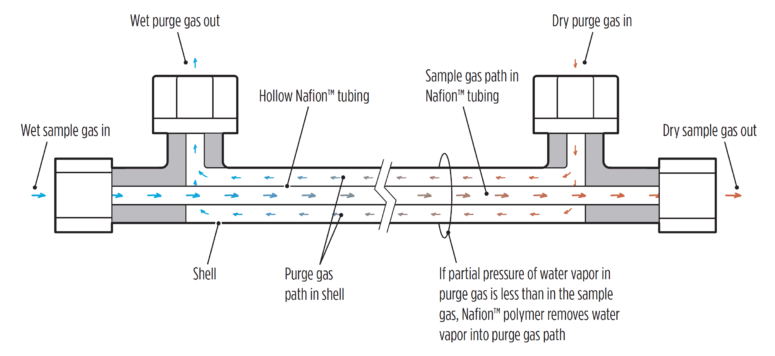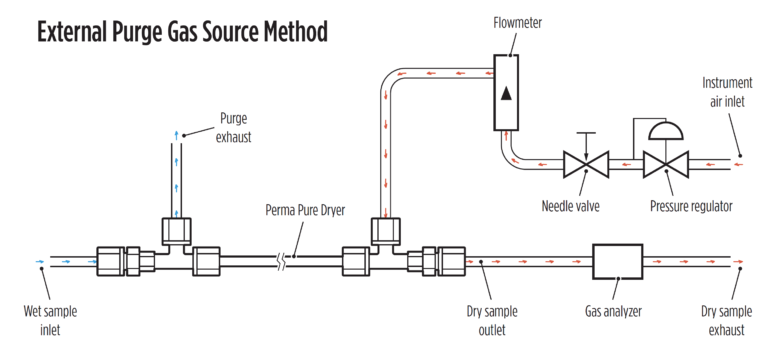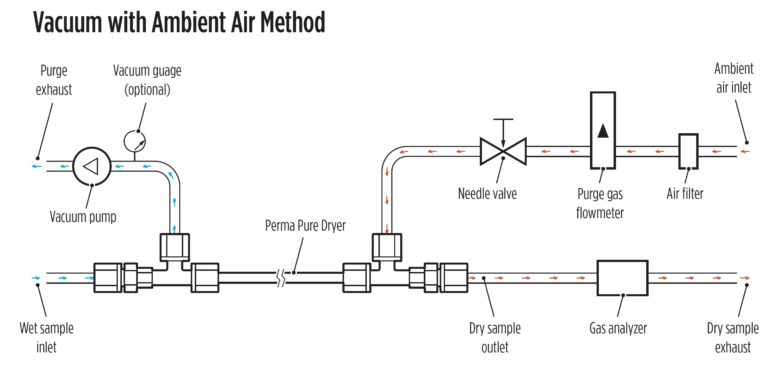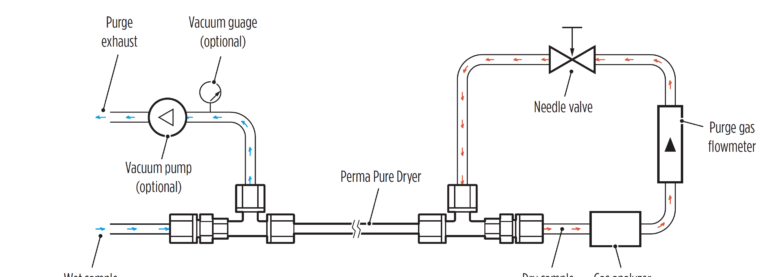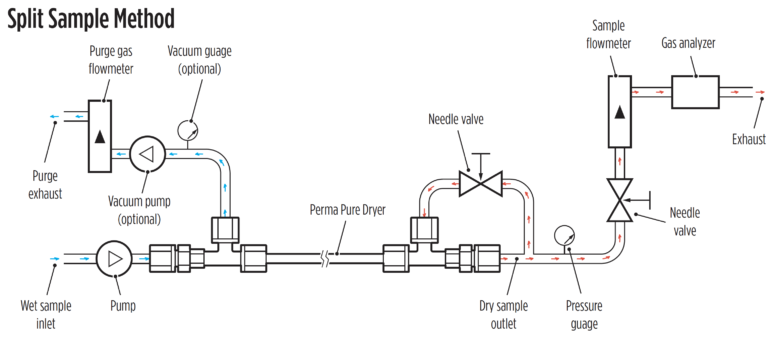Setting up a purge gas source for Perma Pure gas sample dryers.
What is a purge gas?
A purge gas is a dry, clean gas that is directed through the purge gas pathway of Perma Pure dryers, countercurrent to the flow of the sample gas through the Nafion™ tubing. It is important that the purge gas is drier than the sample gas: when the partial pressure of water vapor in the purge gas is less than the sample gas, Nafion™ polymer removes water vapor from the sample path into the purge gas path.
External Purge Gas Source Options
Using an external purge gas source means directing instrument air, compressed air, nitrogen or other cylinder gas through the purge gas flow path.
The three types of external purge gas sources we recommend, ranked by drying performance, are listed below:
- Nitrogen or other Cylinder gas – using ultra-dry cylinder gas with a typical dew point of -60° or -70°C can yield even lower output dew-point results than shown on our performance curves. However, this method might not be cost effective for continuous or high flow rate applications. Recommended for intermittent or batch analyses.
- Instrument Quality Air – instrument air is typically found at most industrial plants and in many labs. Instrument air is dry, clean air with a dew point near -40° C. Recommended for continuous or high flow applications.
- Compressed Air – typically run through a refrigerator condensation dryer, compressed air can have a dew point as low as -20° C once expanded to atmospheric pressure. At this dryness level, compressed air still performs comparably to instrument quality air. However, it is important that compressed air is filtered and oil-free. If not, oil, dirt, and particulate contamination will reduce the performance of the dryer over time by blocking its water transfer pathways.
Other Purge Gas Source Options
Not using an external purge gas source means pulling atmospheric air, dry recycled sample gas, or dry analyzer exhaust, via vacuum, through the purge gas flow path to serve as the purge gas.
These are the methods of choice when no external purge gas source is available or desired.
Three purge gas methods that can be used when no external purge gas source is available are ranked by drying performance below:
- Vacuum with recycled dry sample gas (Split Sample Method) – a percentage of the dried sample gas, pulled through the purge gas flow path by vacuum, can serve as a purge gas source. In this case, different combinations of sample and purge gas flow rate, percent sample gas used as purge gas, dryer choice, and vacuum pump choice will affect performance and will need to be tuned to find the parameters yielding optimal performance.
- Vacuum with dry analyzer exhaust (Reflux Method) – the dry exhaust from the gas analyzer is pulled through the purge gas flow path by vacuum. In this case, the sample and purge gas flow rates (mass flow) are the same and all of the sample gas is used as purge. Every combination of sample and purge gas flow rate, dryer choice, and vacuum pump choice will affect performance and will need to be tuned to find the parameters yielding optimal performance.
- Vacuum with Atmospheric Air – atmospheric air, pulled through the purge gas flow path by vacuum, can serve as a purge gas source. In this case, every combination of flow rate, dryer, and vacuum pump will affect performance and will need to be tuned to find the parameters yielding optimal performance. Ensure the humidity of the atmospheric air remains consistent.
Note that air used needs to be clean or otherwise filtered and oil-free. If not, oil, dirt, and particulate contamination will reduce the performance of the dryer over time by blocking its water transfer pathways.
External Purge Gas Source
In this method, an external purge gas source, such as instrument air, nitrogen or cylinder air, or dry and clean compressed air is used.
Setup
Install two humidity dew point sensors, one before the dryer entrance and one after the dryer exit. These are required to measure the drying performance of the system.
Install a pressure regulator, needle valve, and flow meter ahead of the purge gas inlet.
Connect external purge gas source to the pressure regulator inlet.
Calibration
Start with purge gas flow rate at 2-3x the sample gas flow rate.
Keeping an eye on the humidity dew point sensor reading, incrementally decrease the purge gas flow rate until target performance is reached with lowest purge gas flow rate possible– you might find you can still get good performance with a purge gas flow rate as low as 0.5x the sample gas flow rate.
Note
Air used as a purge needs to be clean or otherwise filtered and oil-free. If not, oil, dirt, and particulate contamination will reduce the performance of the dryer over time by blocking its water transfer pathways.
Vacuum with Ambient Air
In this method, ambient air is filtered and used as the purge gas, pulled through the purge gas flow path by vacuum.
Setup
Install a vacuum pump at the purge gas outlet and a flow restriction device (such as a needle valve or capillary tube) before the purge gas inlet.
Install two humidity dew point sensors, one before the dryer entrance and one after the dryer exit. These are required to measure the drying performance of the system.
Calibration
Pull maximum vacuum, then begin slowly restricting flow with the needle valve.
Keeping an eye on the humidity dew point sensor reading, find the amount of flow restriction where dew point it lowest. If the flow is restricted too much, the dew point start to increase again.
Note
Note that drying performance will be dependent upon the moisture level of the atmospheric air, however, this effect may be negated: as ambient air entering the purge gas path expands in volume and moisture content per volume decreases.
Air used as a purge needs to be clean or otherwise filtered and oil-free. If not, oil, dirt, and particulate contamination will reduce the performance of the dryer over time by blocking its water transfer pathways.
Vacuum with Analyzer Exhaust (Reflux Method)
In this method, analyzer exhaust is re-routed to become the purge gas source. It is pulled through the purge gas path by vacuum.
Setup
Install a vacuum pump at the purge gas outlet and a flow restriction device (such as a needle valve or capillary tube) before the purge gas inlet.
Connect gas analyzer exhaust, through a flow meter(optional), to the needle valve input.
Install two humidity dew point sensors, one before the dryer entrance and one after the dryer exit. These are required to measure the drying performance of the system.
Calibration
Pull maximum vacuum, then begin slowly restricting flow with the needle valve.
Keeping an eye on the humidity dew point sensor reading, find the amount of flow restriction where dew point it lowest. If the flow is restricted too much, the dew point start to increase again.
Note
If sample gas contains corrosive chemicals, materials in the flow path need to chemically compatible.
Vacuum with Dry Sample Gas (Split Sample Method)
In this method, a percentage of dried sample gas is used as a purge gas source.
Setup
Install the sample pump, shown at the inlet of the dryer, anywhere along the sample path. Take care to evaluate the effect of pressure that may develop at the pump outlet -too much pressure can both damage certain components and cause condensate to form.
Install a vacuum pump at the purge gas outlet and a flow restriction device (such as a needle valve or capillary tube) before the purge gas inlet.
Connect the dry sample gas outlet to the needle valve input, so that some of the sample is directed to both the analyzer and the purge gas path.
Install two humidity dew point sensors, one before the dryer entrance and one after the dryer exit. These are required to measure the drying performance of the system.
Setup Notes
Pull maximum vacuum, then begin slowly restricting flow with the needle valve.
Keeping an eye on the humidity dew point sensor reading, find the amount of flow restriction where dew point it lowest. If the flow is restricted too much, the dew point start to increase again.
Then, reduce the purge gas flow in 10% increments until best performance is found. The performance of your drying system is increased by reducing the percentage of dry sample gas directed through the purge gas flow path.
Note
If sample gas contains corrosive chemicals, materials in the flow path need to chemically compatible.
For this method, a dryer with higher flow rate capacity may be needed, however, this method can perform comparably to using an external purge gas source.

